Intel Core i7 3820 Review: $285 Quad-Core Sandy Bridge E
by Anand Lal Shimpi on December 29, 2011 2:28 AM EST- Posted in
- CPUs
- Intel
- Sandy Bridge
- Sandy Bridge E
If you are a normal desktop user or even a power user with plans to run at over 4GHz, the vanilla LGA-1155 Sandy Bridge platform is good enough. You get some of the fastest CPUs on the market today paired with reasonably priced motherboards and the ability to use Quick Sync to transcode video...er...quickly. If that's not enough, Intel launched a higher end platform last month: the LGA-2011 Sandy Bridge E.
Take a regular Sandy Bridge, add PCIe 3.0 support, increase the number of PCIe lanes that branch off of the CPU (from 16 to 40 lanes), double the number of memory channels (4 x 64-bit DDR3 memory controllers) and you've got Sandy Bridge E and its LGA-2011/X79 platform. SNB-E is currently available in two forms: a $999 6-core Extreme Edition part (Core i7 3960X) and a $555 6-core unlocked version (Core i7 3930K). Neither is exactly cheap but if you need the PCIe lanes, core count and memory bandwidth, they are your only ticket.
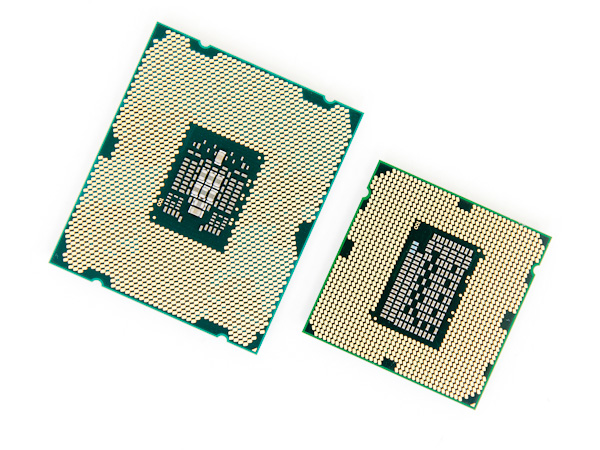
LGA-2011 SNB-E (left) vs. LGA-1155 SNB (right)
Sandy Bridge E is a fairly niche platform to begin with, but what about the niche within the niche (extremeception?) of users who just need the LGA-2011 platform but not necessarily a 6-core behemoth? For those users, there's the Core i7 3820:
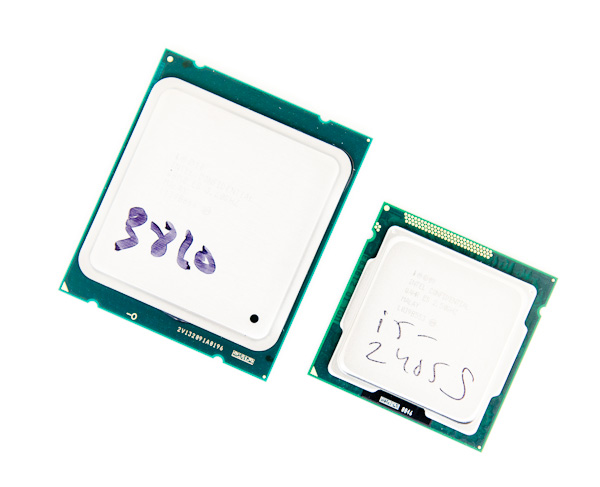
LGA-2011 SNB-E (left) vs. LGA-1155 SNB (right)
The Core i7 3820 is the first (and only) quad-core Sandy Bridge E CPU. It's so new that the chip isn't even available for sale nor will it be until early 2012. Unlike the relationship between the 3960X and 3930K, the 3820 is an entirely new die.
The chip features four Sandy Bridge cores and is paired with a 10MB L3 cache, giving it a slight advantage over the highest end LGA-1155 Sandy Bridge CPUs on the market today. The result is a die that's bigger than a regular SNB but significantly smaller than a 6-core SNB-E:
| CPU Specification Comparison | ||||||||
| CPU | Manufacturing Process | Cores | Transistor Count | Die Size | ||||
| AMD Bulldozer 8C | 32nm | 8 | 1.2B | 315mm2 | ||||
| AMD Thuban 6C | 45nm | 6 | 904M | 346mm2 | ||||
| AMD Deneb 4C | 45nm | 4 | 758M | 258mm2 | ||||
| Intel Gulftown 6C | 32nm | 6 | 1.17B | 240mm2 | ||||
| Intel Sandy Bridge E (6C) | 32nm | 6 | 2.27B | 435mm2 | ||||
| Intel Sandy Bridge E (4C) | 32nm | 4 | 1.27B | 294mm2 | ||||
| Intel Nehalem/Bloomfield 4C | 45nm | 4 | 731M | 263mm2 | ||||
| Intel Sandy Bridge 4C | 32nm | 4 | 995M | 216mm2 | ||||
| Intel Lynnfield 4C | 45nm | 4 | 774M | 296mm2 | ||||
| Intel Clarkdale 2C | 32nm | 2 | 384M | 81mm2 | ||||
| Intel Sandy Bridge 2C (GT1) | 32nm | 2 | 504M | 131mm2 | ||||
| Intel Sandy Bridge 2C (GT2) | 32nm | 2 | 624M | 149mm2 | ||||
There's a small improvement in base clock frequency over the fastest SNB (3.6GHz vs. 3.5GHz) but max turbo remains unchanged at 3.9GHz. For single threaded applications the 3820 should be just as fast as a Core i7 2700K or a 3960X. The same is true for if all heavily threaded workloads, at least when compared to other quad-core parts (the 3960/3930 still maintain an advantage because of their two additional cores).
| Processor | Core Clock | Cores / Threads | L3 Cache | Max Turbo | Max Overclock Multiplier | TDP | Price |
| Intel Core i7 3960X | 3.3GHz | 6 / 12 | 15MB | 3.9GHz | 57x | 130W | $990 |
| Intel Core i7 3930K | 3.2GHz | 6 / 12 | 12MB | 3.8GHz | 57x | 130W | $555 |
| Intel Core i7 3820 | 3.6GHz | 4 / 8 | 10MB | 3.9GHz | 43x | 130W | $285 |
| Intel Core i7 2700K | 3.5GHz | 4 / 8 | 8MB | 3.9GHz | 57x | 95W | $332 |
| Intel Core i7 2600K | 3.4GHz | 4 / 8 | 8MB | 3.8GHz | 57x | 95W | $317 |
| Intel Core i7 2600 | 3.4GHz | 4 / 8 | 8MB | 3.8GHz | 42x | 95W | $294 |
| Intel Core i5 2500K | 3.3GHz | 4 / 4 | 6MB | 3.7GHz | 57x | 95W | $216 |
| Intel Core i5 2500 | 3.3GHz | 4 / 4 | 6MB | 3.7GHz | 41x | 95W | $205 |
There's no on-die GPU, no heatsink/fan in the box and this isn't a fully unlocked part so the 3820 is actually cheaper than most of the high-end Sandy Bridge CPUs: it's priced at $285. If it weren't for the fact that you'll still need to spend over $200 on a motherboard I would say that the 3820 is a steal.
Overclocking
Let's start with the basics. All Sandy Bridge CPUs are clock locked by default, they can't operate at frequencies other than what they're sold at. There are two exceptions to this rule. All Sandy Bridge CPUs that support Turbo Boost are partially unlocked. Not only can they turbo up to frequencies that are higher than their default clock, but they can also be overclocked to frequencies even higher than their turbo speeds. By default, all Turbo enabled Sandy Bridge CPUs can be set to run at up to four bins (4 * bclk or 400MHz by default) higher than their standard turbo frequencies:
The second exception is any of the K or X-series SKUs. If your Sandy Bridge model number ends in a K or X, then the chip is fully unlocked and can be overclocked up to 5.7GHz using only clock multiplier adjustments.
The Core i7 3960X and 3930K fall into the latter category, which makes overclocking them a breeze. The 3820 on the other hand is partially unlocked, which means that we can run it at up to 4.3GHz using multiplier adjustments alone. Note that the 4.3GHz limit only applies to the 1-core active state, in the worst case scenario of all cores active with no room to turbo the highest operating frequency of the chip when overclocked would be 4.0GHz.
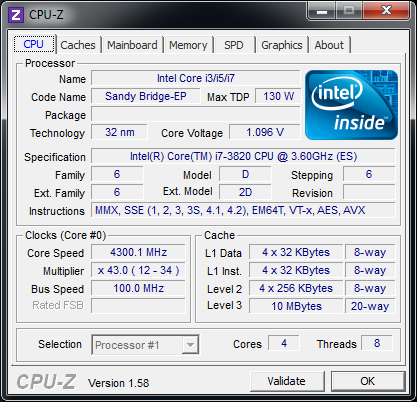
The max 3820 overclock without touching bclk settings
While these aren't bad targets, they're not all that exciting either. Thankfully Sandy Bridge E makes it even easier to overclock through the use of a few higher bclk frequencies. By default Sandy Bridge uses a 100MHz bclk, but SNB-E allows for 125MHz, 166MHz and 250MHz options as well. The 166/250MHz settings are a bit too aggressive, but the 125MHz bclk setting proved to be the perfect companion for the 3820.
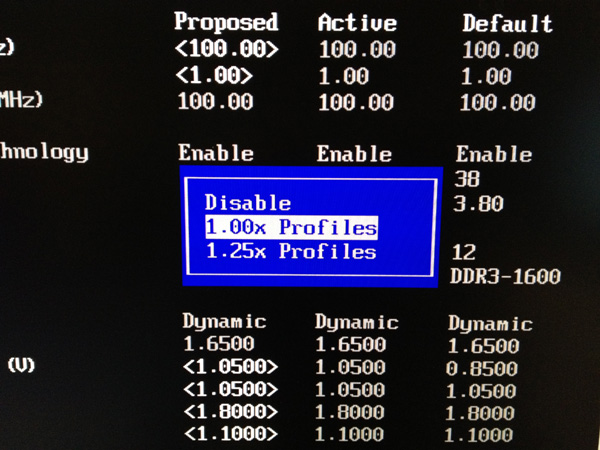
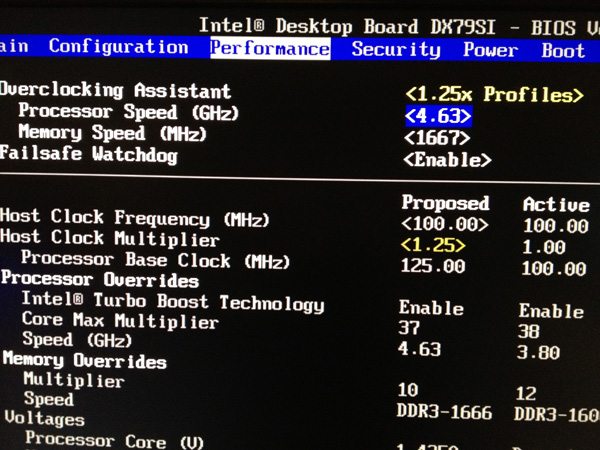
Intel's DX79SI makes it extremely easy to overclock, especially with the latest BIOS update. There are built in overclocking profiles for each bclk setting that you can choose from. I simply selected the 1.25x (125MHz) profile option and then went through the list of target frequencies until I found one that seemed promising. I also went in and tweaked some of the settings myself to get a bit more clock speed (4.63GHz is the fastest profile this board allows by default) and improve stability. In the end I was fairly pleased with what the 3820 could do: 4.75GHz with Intel's RTS2011LC closed loop cooling system.
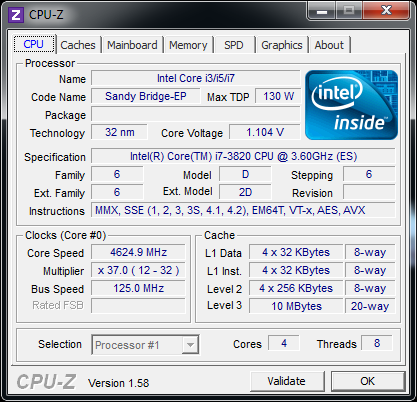
Now we're talking
I couldn't get the 3820 as stable as I would like at 4.88GHz and 5GHz was unfortunately out of the reach of my sample. I can't really complain about 4.75GHz from a $285 chip though, especially without resorting to anything too exotic from a cooling standpoint. Overclocking is also extremely effortless thanks to the new bclk options on SNB-E. Although the Core i7 3820 isn't an unlocked part, that doesn't limit how far (or how easily) it can be overclocked. A big part of the ease of overclocking is due to how good of a job Intel did on the DX79SI BIOS options, but from what we've seen the third party boards also do a decent job of simplifying the process.
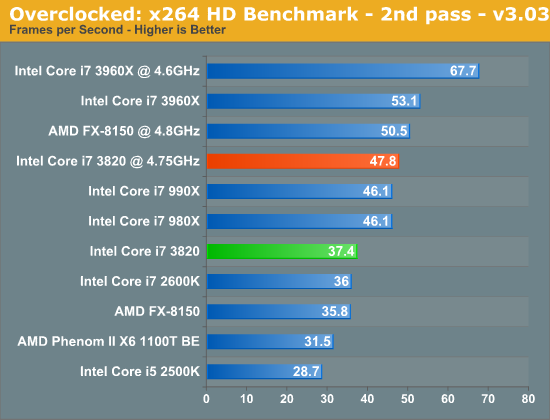
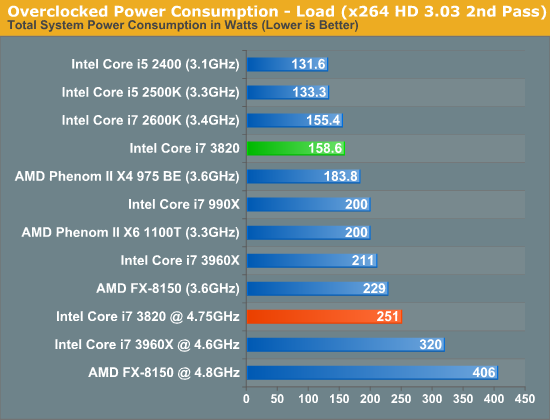
The Test
To keep the review length manageable we're presenting a subset of our results here. For all benchmark results and even more comparisons be sure to use our performance comparison tool: Bench.
| Motherboard: |
ASUS P8Z68-V Pro (Intel Z68) ASUS Crosshair V Formula (AMD 990FX) Intel DX79SI (Intel X79) |
| Hard Disk: |
Intel X25-M SSD (80GB) Crucial RealSSD C300 |
| Memory: | 4 x 4GB G.Skill Ripjaws X DDR3-1600 9-9-9-20 |
| Video Card: | ATI Radeon HD 5870 (Windows 7) |
| Video Drivers: | AMD Catalyst 11.10 Beta (Windows 7) |
| Desktop Resolution: | 1920 x 1200 |
| OS: | Windows 7 x64 |


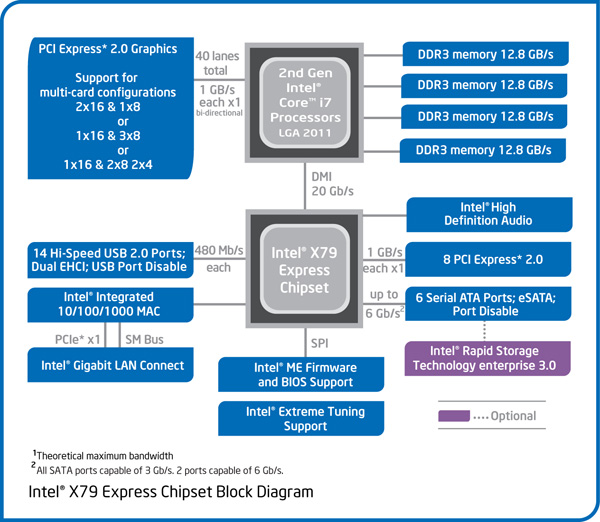









84 Comments
View All Comments
horangl3e - Thursday, December 29, 2011 - link
So if a user were to buy two graphics cards, the gtx 580 for example, would it be more beneficial for that user to use the X79 platform instead of the Z68? Currently I believe that the user would have to split between x8 x8 for each graphics card if they used the non X79 platform but with the X79 both cards would be able to use the proper x16 bandwith for both graphics cards right?chizow - Thursday, December 29, 2011 - link
There's not much benefit when using 2xPCIE 2.0 single-GPU cards with PCIE 2.0 x8 slots. They just don't need that much bandwidth.With multi-GPU cards however, that PCIE 2.0 x8 starts to choke them a bit and x16 starts showing its benefits.
Another thing to keep in mind too is that with X79 (and IB?) they support PCIE 3.0, so with PCIE 3.0 cards, PCIE 3.0 x8 is the equivalent of PCIE 2.0 x16 in terms of bandwidth. Should be beneficial for multi-card solutions especially with multi-GPU cards.
I'm assuming Ivy Bridge will also be PCIE 3.0 compliant, but if not, X79 might be even more appealing to people looking to buy the next-gen GPU offerings from AMD/Nvidia.
Also, Anand or anyone else, since the PCIE controllers are on the CPU dies now, is it possible for SB to support PCIE 3.0 as well? Or are they just too different?
B3an - Thursday, December 29, 2011 - link
Sandy Bridge could never support PCI-E 3.0 without a pretty major revision to the CPU's. Even then i'm not sure if the motherboards would actually work with it.If i was buying a quad core right now i would actually go for this i7 3820 over a 2500 - 2700K. Simply because it's more future proof for graphics cards. While no card needs more than x16 PCI-E 2.0 right now for games they certainly will in the future. Plus with SNB-E you can run two cards at x16 @ PCI-3.0 speed, but with SB it's only x8 @ 2.0 speed which already takes a slight performance hit with current cards. The graphics upgrade path for SNB-E will last for years to come.
Tchamber - Thursday, December 29, 2011 - link
I have a Gulftown i7, and doesn't it support PCIe at 16x16? I didn't know Intel took a step back with SNB and PCIe lanes for multi GPUs. Do I understand this right?SlyNine - Thursday, December 29, 2011 - link
I believe with Gulftown the PCI-E Controller is not based on the CPU. Thats why you can get 16x16x8 with them.SlyNine - Thursday, December 29, 2011 - link
By based of course I mean located.DanNeely - Thursday, December 29, 2011 - link
LGA1366 supports 32 PCIe 2.0 lanes. That is more than LGA 1155's 16, but LGA 1155 isn't the official successor to 1366 (even if SB is fast enough it's quads beat 1366 hexes on many benches); it's the LGA 1156 replacement and 11556 also only has 16 2.0 lanes. LGA 2011 replaces LGA 1366 (and LGA 1567 on high end Xeons); and is a major PCIe upgrade.dgingeri - Thursday, December 29, 2011 - link
Actually, the x58 chipset supports 36 lanes from the northbridge and 6 more form the southbridge: http://www.intel.com/Assets/Image/diagram/X58_bloc...This allows three slots using x16/x16/x4 with 6 more for expansion devices or x16/x8/x8 with 10 more for expansion devices. (My P6T is the former while my Rampage III Formula is the latter. Yes, I have 2 lga1366 systems, one a server and one a gaming machine.)
The 40 lanes from the processor and the 8 lanes from the chipset will be a big boost for using certain devices. I'll be able to run both my video cards at x16 while still using my 10Gbe and LSI RAID cards with x8 slots. :)
chizow - Thursday, December 29, 2011 - link
SNB/P67/Z68 was the successor to the short-lived Lynnfield/Clarkdale P55-based platforms.SB-E/X79 is the direct successor to Nehalem/Gulftown/X58.
Intel has just had the luxury of pushing back the release dates of their parts because no matter what they sell, its faster than AMD and still netting them boatloads of cash.
So yes, for some time Intel's leading CPUs have been behind on the platform side of things, SB-E settles the balance and represents an upgrade over Nehalem in every aspect.
This will change again however with IVB, which will be on a smaller process node and probably swing the clockspeed, Turbo, overclocking, and power consumption considerations back in favor of the weaker P67/Z68 platform.
The main difference however is that IVB will also support PCIE 3.0 so the fewer PCIE lanes will be less of a disadvantage on cards that support PCIE 3.0 when used in multi-GPU configs.
Kevin G - Thursday, December 29, 2011 - link
Ivy Bridge will be supported on current socket 1155 motherboards. It'll bring PCI-E 3.0 but currently motherboards are going to be hit or miss if they support that speed. Intel won't officially support PCI-E 3.0 withe P67/Z68 (and related) chipsets but motherboard manufacturers can take that burden if they choose.The main reason to go with socket 2011 isn't a single GPU but rather running multiple GPU's that'll need that bandwidth. For gaming, the performance difference is only a few percentage points. For GPGPU, the difference is greater but if that is the target market, then using a multi-socket 2011 motherboard populated with Xeons is more likely. That'd allow for four PCI-E 16x and two PCI-E 8x lanes all at 3.0 speeds.
For the majority of consumers, socket 1155 will remain good enough for 2012.